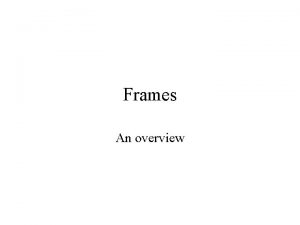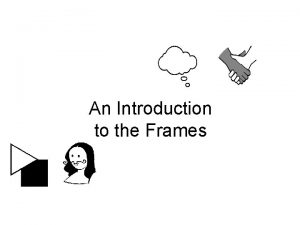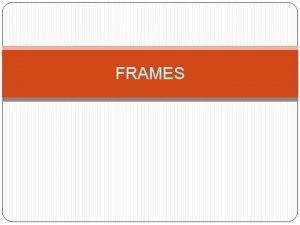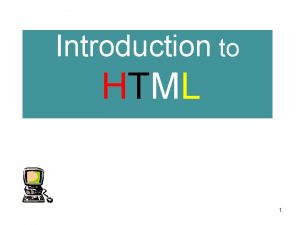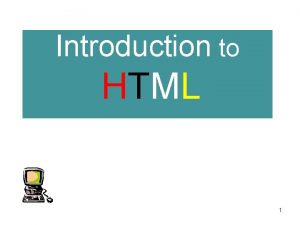An Introduction to the Frames Frames There is
















- Slides: 16

An Introduction to the Frames

Frames • There is more than one way to approach the making of art. • The four Frames were designed as a tool to help understand different points of view about art.

The Subjective Frame • The Subjective Frame looks at personal experiences, emotion and imagination.

A fishing boat and a steamer in rough seas • Look at the painting of a boat caught in a violent storm. Does the painting evoke physical sensations? • Does the scene evoke emotions? • Can you get a sense of movement? Can you imagine the sounds of the waves crashing? Andreas Achenbach, A fishing boat and a steamer in rough seas, 1869. Oil on canvas, 71. 5 × 101 cm.

The Garden of Earthly Delight • Our minds have the capacity for imagination, an ability to visualise images beyond our solid world. Hieronymus Bosch, The Garden of Earthly Delight, 1504, oil on panel, triptych, centre 220 × 195 cm, each wing 220 × 97 cm, Museo del Prado, Madrid, p. 54.

The Cultural Frame • From the viewpoint of the Cultural Frame, we become aware that every thing and everybody exists in a network of relationships. • ‘No man is an Island, entire of itself; every man is a piece of the Continent, a part of the main’ (John Donne, poet)

• An artwork does not appear out of a vacuum. • Artworks reflect some part of the wider world around them, the culture in which they were created. • Culture can be thought of as ideas and values that are shared by groups of people.

Great Southern Land • The image (right) was created by Chinese-born Sydney-based artist Guan Wei. By looking at the way the mountains, plants and rivers are painted, you can see that his playful graphic style is informed by traditional Chinese art. Guan Wei, The Great Southern Land (detail), 2006, courtesy of the artist, Powerhouse Museum and Sherman galleries. Photographed by Jean Francois Lanzarone, p. 56.

The Structural Frame • The Structural Frame looks at how art is put together and how signs and symbols communicate meaning.

Boy • The Structural Frame also focuses on the physical nature of artmaking. • What is the artwork made of? • How big is it? How is it put together? • How can different materials express different ideas? Ron Mueck, Boy, 2000, fibreglass, resin, silicone, 500 cm tall, on display at the 49 th Venice Biennial, p. 57.

• Think about how art uses a visual language. • Imagine if you used an image of a heart in your art making. What ideas would it communicate?

• If you represented the heart in a different way, such as this, would the meaning be the same?

The Postmodern Frame • The Postmodern Frame takes its name from ‘postmodernism’, which is a movement of wide-ranging ideas and theories. • Postmodern thinkers reject the idea of absolute truths.

• With postmodernism, established ideas of what is valuable and significant and what is not are questioned and challenged. • Is an opera by Mozart any better than a threeminute rap from 50 Cent? Who says so?

She has a hot price • Artists who work in a postmodern way often appropriate (copy) images from other sources. • In the image (right), a student has appropriated an image of the Mona Lisa and added a barcode sticker. What do you think the artist is trying to say? Student work, She has a hot price, 2007, digital print, 34 × 26 cm, artist’s collection.

Summary • The four Frames: Subjective, Cultural, Structural and Postmodern, can be used as a helpful tool for organising your thoughts. • A student can look through each Frame and examine their artmaking and the artmaking of others from particular points of view.
 Hát kết hợp bộ gõ cơ thể
Hát kết hợp bộ gõ cơ thể Frameset trong html5
Frameset trong html5 Bổ thể
Bổ thể Tỉ lệ cơ thể trẻ em
Tỉ lệ cơ thể trẻ em Chó sói
Chó sói Chụp phim tư thế worms-breton
Chụp phim tư thế worms-breton Bài hát chúa yêu trần thế alleluia
Bài hát chúa yêu trần thế alleluia Môn thể thao bắt đầu bằng chữ f
Môn thể thao bắt đầu bằng chữ f Thế nào là hệ số cao nhất
Thế nào là hệ số cao nhất Các châu lục và đại dương trên thế giới
Các châu lục và đại dương trên thế giới Công thức tính độ biến thiên đông lượng
Công thức tính độ biến thiên đông lượng Trời xanh đây là của chúng ta thể thơ
Trời xanh đây là của chúng ta thể thơ Mật thư tọa độ 5x5
Mật thư tọa độ 5x5 Phép trừ bù
Phép trừ bù Phản ứng thế ankan
Phản ứng thế ankan Các châu lục và đại dương trên thế giới
Các châu lục và đại dương trên thế giới Thơ thất ngôn tứ tuyệt đường luật
Thơ thất ngôn tứ tuyệt đường luật

















